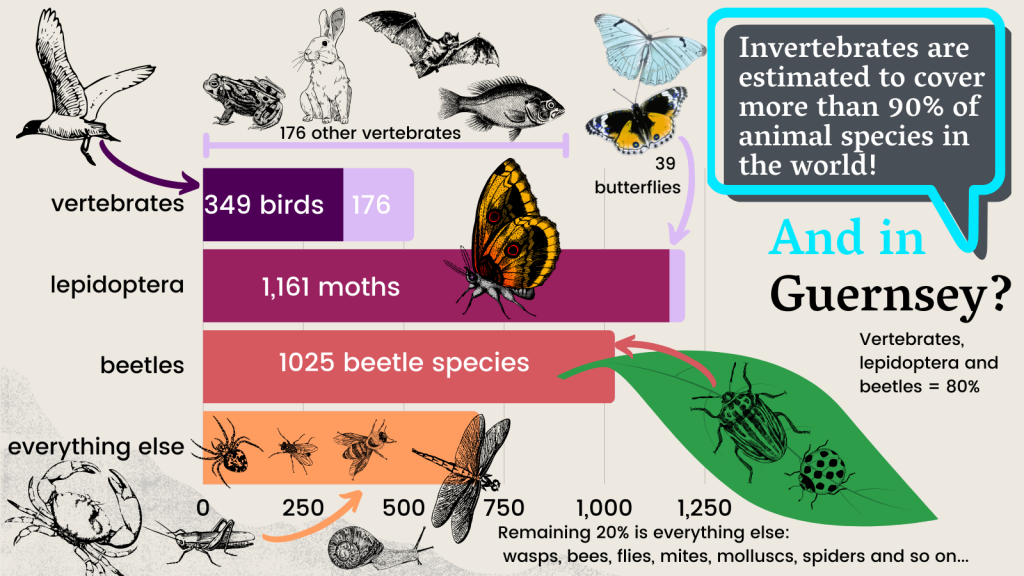Lihou BioBlitz What an incredible day we had at Lihou...
Read MoreThe Love of Invertebrates
Andy Marquis
2nd March 2021
Maybe we need to start with what an invertebrate is. An invertebrate is any animal that lacks a vertebral column, or backbone. Invertebrates are generally soft-bodied animals that lack a rigid internal skeleton but often possess a hard outer skeleton (like a crab or beetle).
So why choose invertebrates?
• Huge number of species.
• Finding them – they can be found anywhere.
• Size – can be microscopic or giant.
• Colourful.
• Identification – something for everyone from easy to very difficult if you like a challenge.
• Lifestyles – some might be considered gross and others cool.
Number of species
Invertebrates are estimated to cover more than
90% of animal species in the world!
Guernsey is no different, although I feel that invertebrates will cover more than 90% of the local fauna. Birds are the most numerous local vertebrate and they are only 349[1] species, other vertebrates are 176 species (including fish, bats, mammals etc.) a total of 525 species. The local Lepidoptera (moths – 1,161[2] and butterflies – 39[3] ) come in at 1,200 species so invertebrates are already at 70% of local fauna, add the 1,025 species of beetle and we get to 80% before we consider wasps, bees, flies, mites, crabs, molluscs, spiders and so forth.
Bailiwick Bat Survey
Bailiwick Bat Survey Citizen Science Project 15th April 2021 The...
Read MoreThe Love of Invertebrates
The Love of Invertebrates Andy Marquis Guernsey Wildlife 2nd March...
Read MoreJanuary 2021 Lockdown
Further update: 19th February 2021 This week the States of...
Read MoreThe short story is that you can never really run out of things to look for, identify and enjoy. If you get excited about the potential of finding something new or different, whether that be new to Guernsey, the CI, the UK or just plain new to science, then the invertebrates are where you should probably invest some time. The recent discovery of a new species of whale was perhaps a surprise, but then the ocean is big, but a new species in your back garden?
Entirely possible if you scale it down. Even more likely to find things new to Guernsey if you choose one of the less well studied groups.
Finding Invertebrates:
Invertebrates are literally everywhere. Inside your house, the garden, the patio and from the local park to the deepest rainforest.
A quick search will provide many species and specimens to look at even if you think you have nowhere to look, there will be plenty to find even on a patio, under a plant pot, under old bricks or slabs, check any old logs or bits of bark or in the compost heap. Go to the beach and look under rocks, rummage through a grass tussock on the common see what you can find.
You can of course venture further afield to more exotic locations and different habitats which are not available locally but unless you want to see something specific, they are all available right on your doorstep.
Size:
Invertebrates come in all shapes and sizes, they can be very small (microscopic in many cases) or very large (the giant squid can grow to more than 13m).
There are many families which are of a manageable size, say the woodlice or shieldbugs, and relatively easy to locate and identify.
Colours:
As well as a huge variation in size, you can find an invertebrate in a huge variety of colours of the spectrum, some even change their colours (e.g. Squid and Jellyfish), the smaller invertebrates are what can surprise you the most, a tiny springtail, less than 2mm long looks like no colour at all until you get in close and the colours and patterns of hair are just incredible. Nature really shows you when on the small scale just how incredible it is.
Ease of identification:
If you like a challenge, there are some orders which are more tricky to identify requiring microscopic examination of a specimen, however others are easier and possible to do with reasonable photographs for nearly all species in the family.
Lifestyles and Interest:
The varying lifestyles of invertebrates will provide a plethora of different things to look at, enjoy and research. Some live for poo, others bury rotting carcasses, some like stinky rot holes, many are parasitic of other species laying their eggs inside a living host where the larva feed on the host from the inside until they burst forth like something Sigourney Weaver would be chasing about on the big screen.
Whilst talking of films and TV, many of the “monsters” on screen have been based on real life invertebrates and their real life habits.
Does the mouth of this 2mm long springtail remind you of anything from a Sigourney Weaver film?
Maybe many invertebrates could become movie monster inspirations? A closer look at many small everyday insects is fascinating:
A crane fly larva, looks like it wants a hug, but this is the other end…

